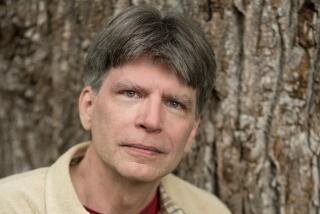Forget ‘fake news’: Adam Curtis’ film says we live in a ‘fake world’ designed by bankers and politicians
A sinister world rises from the soothing, if mischievous, voice of Adam Curtis: politicians and financiers have created alternate realities that prey on our fears while Facebook and other cyberspace distractions toy with our vanities with promises of escape and virtual redemption.
At a time when what we see is often more fantastical than what we dream, Curtis’ new documentary, “HyperNormalisation,” is a disquieting peek into the “trickery” that runs the planet. He weaves an array of images from the last 40 years, including the rise of Donald Trump, the swagger of Vladimir Putin, the bloody end of Libyan despot Moammar Kadafi and, oddly enough, a Jane Fonda workout tape, the killing of a Japanese gambler and clips from Hollywood’s apocalyptic blockbusters.
They all collide in a nearly three-hour documentary that has the sweep of a prairie and the eerie depravity of a bedtime story whispered by the Brothers Grimm. The footage, drawn from the BBC’s archives, glimpses back to the 1970s and follows the world — its corruptions, conflicts, terrorism, hidden hands and technological advances — into what Curtis calls a post-political era driven by banks, financial markets, Silicon Valley and populists like Trump and Putin.
It would be easy to mischaracterize Curtis as a leftist out to expose the establishment. But much of his work is less politically inspired than driven by a suggestion that those in power have bent our ideologies, cultures and even our subconsciousness to their whims. The Occupy Wall Street-type movements that grew out of the last recession excited him until they devolved into stifling rules and bureaucracies.
“Because we’ve all retreated into a simplified view of the world, we haven’t seen where the power has shifted.”
— Adam Curtis, filmmaker
“Because we’ve all retreated into a simplified view of the world, we haven’t seen where the power has shifted,” said Curtis, who has the air of a precocious English schoolboy whose eyes gleam at the hint of conspiracy. “Journalism is a lot to blame for this. Its concentration on very simple stories of goodies and baddies hasn’t seen the power that has gone to” finance, technology and other unaccountable forces.
It is unsettling terrain of audaciousness and irony. Released in Britain last year and available on YouTube, the film, which will have a Los Angeles screening with Curtis on Saturday at the Cinefamily, suggests that politicians have fashioned a “fake world” to obscure complexities they cannot fix. In Curtis’ view, Trump’s condemnation of “fake news” is the latest iteration in a battle between truth and dominance.
The truth — from Moscow to Manila to Mar-a-Lago — is often recast by “alternative facts” and the kind of evasive vocabularies that echo through the novels of Orwell and Kafka. To tune into a news conference by White House Press Secretary Sean Spicer is at once to confront elusiveness and reality TV chutzpah. The known-knowns as it were are, in Curtis’ estimation, being finessed for a new world order that’s challenging the “global society” liberal thought that arose after World War II.
“Maybe it’s not a battle between left and right,” Curtis said of Trump’s election and Britain’s vote to break from the European Union. “Maybe it’s a battle against the idea that we’re all one world and we’re universal…. The other view is that we’re very different societies with different narratives, stories and traditions. That view is dangerous because it can be nationalist.”
A journalist and filmmaker, Curtis, who harnesses jumbles of sequences and selective facts to fuel sprawling narratives, has long peeked behind convention and artifice. His documentaries, including “The Century of the Self,” about how psychoanalysis merged with consumerism, and “The Power of Nightmares,” a look at neo-conservatism and radical Islam, are juxtapositions of images that enthrall, anger and occasionally make you laugh at the spooky ridiculousness of the world.
In person, he’s much like his films, lulling along at a comfortable pace while murmuring sly asides. He showed up at downtown’s Grand Central Market the other day in a button-down white shirt, dangling eyeglasses and a pin-striped blazer. He ordered a coffee and wandered away. “Oh, I’m sorry,” said Curtis, who these days is trolling through 60 years of BBC footage from Russia. “I forgot to pay.” Documentary filmmaker Errol Morris once tweeted: “I want to be Adam Curtis when I grow up.”
“HyperNormalisation” proposes that today’s world was largely shaped by developments in two very different cities in 1975.
New York City’s near economic collapse and a bailout by banks emboldened Wall Street and led to the increasing power of the financial industry on global politics. In Damascus, Syria, meanwhile, Hafez Assad, father of current President Bashar Assad, aspired to unite Arab nations and return Palestinian refugees to their homeland. That threatened U.S. policy in the region and ultimately accelerated the reach of Islamic terrorism.
What emanates from these cities leads us through scrapbooks of recent history: The Cold War, acid flashbacks, punk rockers, Patti Smith, 241 American service personnel killed by a bombing in Lebanon, the fall of Soviet communism, the popularity of Prozac, the allure of artificial intelligence, the hallucinatory realm of cyberspace, the “Arab Spring,” the Syrian war, the fear of global terror and Sissy Spacek drenched in blood in the Stephen King inspired film “Carrie.”
These collages at times offer thin connections to Curtis’ larger point about the designs of those in power. But perhaps no one more than Kadafi makes Curtis’ case about the world’s duplicity and how the narratives constructed for us, especially regarding our anxieties, are often manipulated.
An egomaniac, Kadafi, was a young colonel when he took power and ruled Libya for 42 years. His ambitions and political maneuverings allowed him many guises. President Reagan — after a number of bombings — deemed him a global terrorist, even though, as Curtis reports, Syria was the likely mastermind. This double game gave Kadafi the international stature he craved and the West an eccentric bogeyman. He attempted to slip his bad guy image in the early 2000s, sharing intelligence on Al Qaeda and negotiating trade deals with Washington and London.
British Prime Minister Tony Blair visited him in Tripoli after Kadafi claimed to get rid of weapons of mass destruction. He didn’t have an arsenal of much significance. But, Curtis notes, it made for a good and tidy story. The West, however, did not come to the dictator’s rescue when he was overthrown and assassinated — the images uploaded to YouTube — during the 2011 uprisings that shook the Middle East and North Africa.
The Kadafi saga is “actually very funny in a dark way,” said Curtis. “It tells you a lot about the [Western] establishment, just what they’ve become, how hypocritical. Kadafi, because he was ambitious and rather tragic, said I’ll play any role you want. It somehow seemed to make it true and they all got locked into this thing.”
See the most-read stories this hour »
Twitter: @JeffreyLAT
ALSO:
A view from backstage: How that big Oscars mistake overshadowed months of planning and precision
‘Guess Who’s Coming to Dinner’ is 50 and racial tension still a problem in America
A real life look at the crazy odds and tortured dreams of making it in La La Land
More to Read
Only good movies
Get the Indie Focus newsletter, Mark Olsen's weekly guide to the world of cinema.
You may occasionally receive promotional content from the Los Angeles Times.










